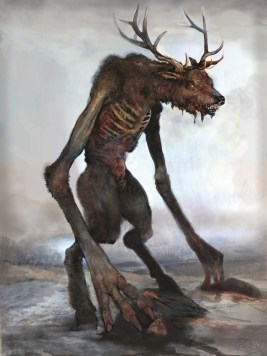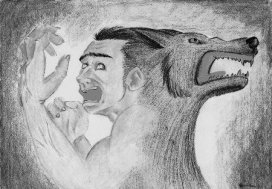The Werewolf.
David Calvert.

“Never stray from the path, never eat a windfall apple, and never trust a man whose eyebrows meet in the middle.” – Company of Wolves.
There are diverse tales concerning werewolf folklore. They span cultural boundaries and can be found in ancient Greek writings up to the present day. In European folklore it is a widespread concept which developed during the medieval period.
In the late 16th century one Peter Stubbe, a Rhenish farmer, was accused of being a “serial killer and “cannibal”. He was also known as the “Werewolf of Bedburg” His trial in 1589 was one of the most lurid and famous trials in history. With the threat of torture hanging over him, he confessed to murdering and cannibalising fourteen children, one of which was his son and two pregnant women.
Vile though his crimes undoubtedly were, this hardly makes him a lycanthrope with the ability to change himself into a wolfman. So where did the notion come from? Unsurprisingly, it came from his own mouth. After being stretched on a rack, and before any further torture began, he admitted to having practiced black magic. He claimed the Devil had given him a magical belt or girdle which enabled him to transform himself into a wolf. On removing it he would change back into a human being. This, however, didn’t save him from the executioner, as he may have hoped it would.
His execution took place on October 31st, 1589, and is recorded as being one of the most brutal on record. Having been lashed to a wheel he had flesh torn from him with red-hot pincers. Then his limbs were broken with the blunt side of an axe to prevent him from returning from the grave. He was then beheaded and burned on a pyre.

According to Montague Summers in his 1928’s acclaimed work ‘The Werewolf’, the origin of the creature goes back a few thousand years. The ancient Greeks may have adopted their concept of lycanthropy from the Phoenician cult, which originated in 1200 BC, and put a different spin on it.

Norway and Iceland
The Werewolf legend is an historical mystery of international proportions, spanning time, locations and cultural folklore. The Norse and Icelandic mythology are an example of cross cultural mythologising; the Aiser religion of the Norse having left elements of their belief system in the Icelandic culture during the time of their colonisation.
The Volsunga Saga is the story of father and son, Sigmund and Sinfjotli.
‘While wandering in the woods, Sigmund and Sinfjotli come upon a hut where they find two spellbound wolf pelts. If put on, either pelt will turn a man into a wolf and will possess the power, cunningness, and valour of wolves. But the pelt can only be taken off every tenth day. Having put on the pelts, Sigmund and Sinfjotli turn into wolves and begin wandering about the forest together. Before they split up, they agreed to howl to each other if either of them encounters seven men to fight at a time. Sinfjotli, the son, breaches the agreement and kills 11 men at one time. Angered, Sigmund fatally injures his son. But then a raven, the messenger of Odin, brings a healing leaf to place on Sinfjotli’s wound. After Sinfjotli is healed from his wound, he and his father take off the enchanted wolf pelts as the tenth day arrived. They burned the pelts to ashes, and freed themselves from the curse of lycanthropy’.
Similar tales of Werewolfism can also be found in north and south America. In Mexico it is known a “Nahual” or “Nagaul”. The north American mythology is mainly borrowed from tales of the European ‘New World’ settlers. In actuality, the contemporary werewolf myth we see today was created by the Americans.
Skinwalkers

Yee naaldlooshii, translated: “with it, he goes on all fours”, is the Navajo name for a witch who use their powers of transmogrification to travel in animal form. it is a kind of subset of the werewolf legends in that it can take the form of a wolf, among other things. An individual is said to gain the power on initiation into the Witchery Way, the Navajo equivalent of a Black Mass.
Though, purportedly , some attempts have been made to shoot or kill one, they are usually unsuccessful, due to them being fast and agile. Sometimes a skinwalker will be hunted down, only to lead to the house of someone known to the tracker. It is said that if a Navajo was to know the person behind the skinwalker they had to pronounce the full name, and about three days later that person would either get sick or die for whatever crime they had committed.
Unlike it’s European counterpart, the Werewolf, the skinwalkers are said to be distinguishable in their human form because their eyes glow like an animals. Another thing that sets them apart from the Werewolf legend is their ability to change form consciously. They appear unaffected by the lunar cycles.
Lycanthropy and the Human Condition.
‘Clinical lycanthropy is defined as a rare psychiatric syndrome that involves a delusion that the affected person can transform into, has transformed into, or is a non-human animal. Its name is connected to the mythical condition of lycanthropy, a supernatural affliction in which humans are said to physically shapeshift into wolves. It is purported to be a rare disorder.’
This clinical condition is linked with the altered states of mind that accompany psychosis. The reality-bending events typically involve delusion and hallucinations in which the individual experiences the transformation in his/her mind, affecting their behaviour. But just how common are they? Dr. Jan Dirk Blom, an assistant professor of psychiatry at the University of Groningen, in the Netherlands, mined the archives of psychiatry to find out.
Blom found that since 1850, there have been 56 original case descriptions of people who believed they were metamorphosing into an animal. Among them, 13 reports met the criteria for clinical lycanthropy, the medical term for having delusions of being able to turn into a wolf. The adjective ‘clinical’ is used to emphasize that the condition doesn’t mean actual lycanthropy, or the ability to metamorphose physically into a wolf, Blom said.
The remaining cases were variants of the condition, with patients having delusional convictions about being a dog, a boa snake, a frog or a bee, according to the study published in the March issue of the journal History of Psychiatry. [10 Controversial Psychiatric Disorders]
“I had expected to find more cases, because in textbooks the condition is mentioned quite often in passing,” Blom said.
But such a low number of clinical lycanthropy cases reported in over 150 years suggests the condition may be even rarer than previously thought, Blom said. Doctors “should take heed not to cry wolf too often.”
There is still much that is unknown about the human psyche and its capabilities. Is it conceivable that it has the ability to literally transform a human into an animal? Of the little that we do know, I would say not. There is no tangible evidence to support such an hypothesis.
© David Calvert 2016
Please note that at the bottom of each blog page there is a “Comments” box and a “Like” button, should you feel inclined to use them. Thank you.
